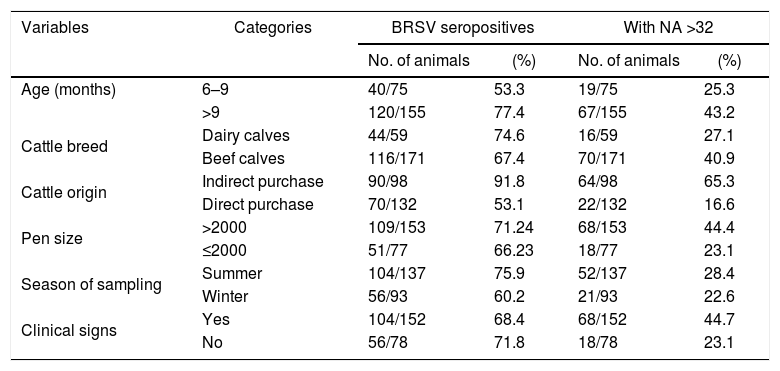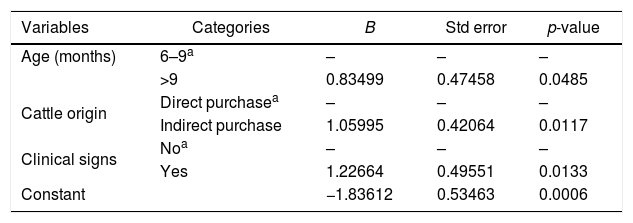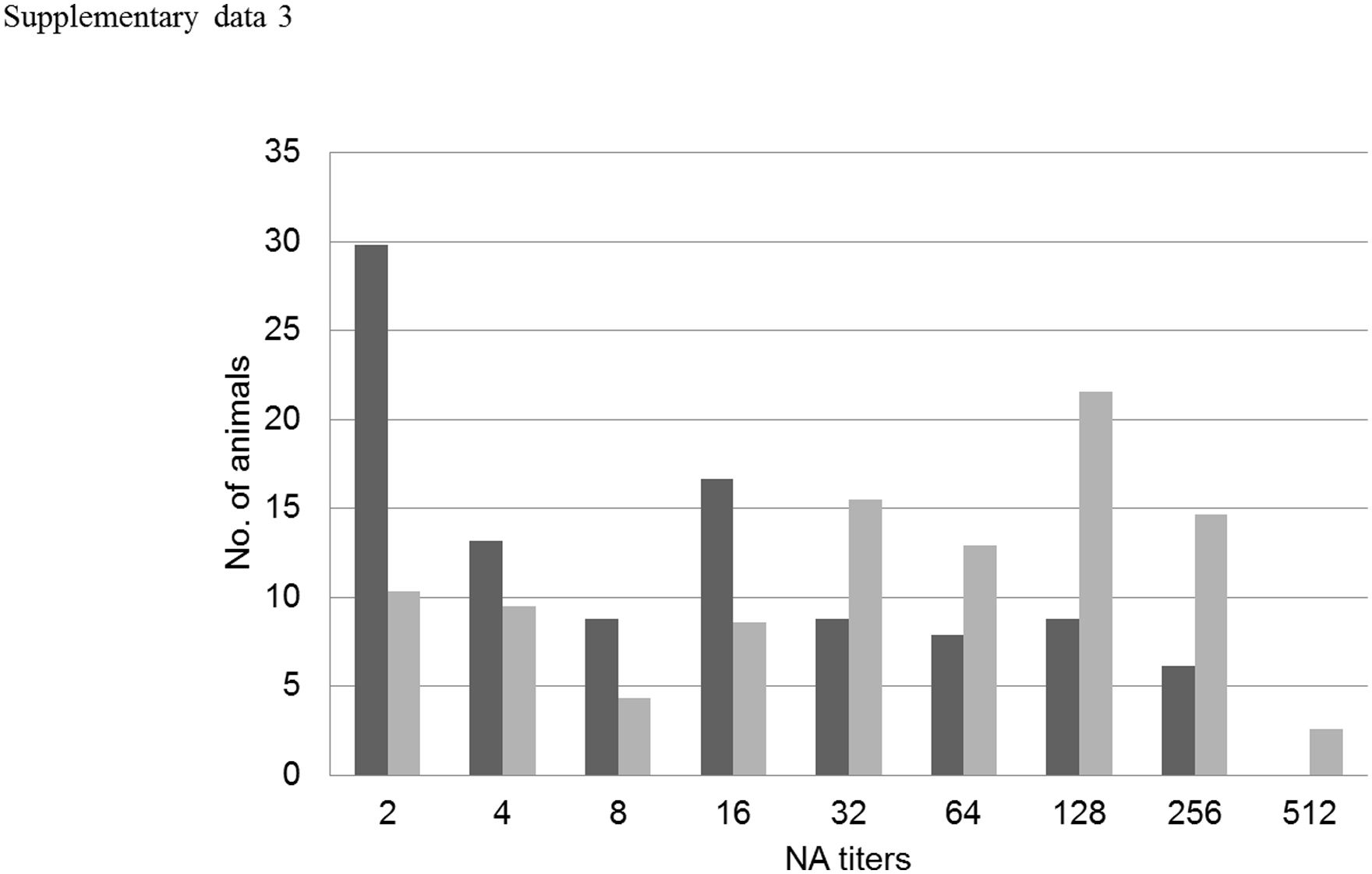Bovine respiratory syncytial virus (BRSV) is one of the causative agents of respiratory disease in cattle all over the world, leading to important economic losses. The aim of this work was to determine the seroprevalence of BRSV in feedlot cattle of Argentina and the risk factors associated with the disease. Results showed a high individual seroprevalence of 78.64% (95% confidence interval adjusted [CI]=66.55–90.75%) against the virus. Positive association was found between the presence of high BRSV neutralizing antibody titers, and the following risk factors: cattle age, source of animals, presence of clinical respiratory signs and herd size. This work contributes to updating the understanding of its epidemiology in Argentinean feedlots and poses the need for reevaluating vaccination strategies against this virus in order to control infection and its impact on productivity.
El virus respiratorio sincicial bovino (BRSV) es uno de los agentes causantes de enfermedad respiratoria bovina a nivel mundial, conduciendo a importantes pérdidas económicas. El objetivo de este trabajo fue determinar la seroprevalencia del BRSV en bovinos de engorde a corral de Argentina y estudiar los factores de riesgo asociados. Los resultados mostraron una elevada seroprevalencia individual del 78,64% (IC=66,55-90,75%) contra el virus. Se encontró una asociación positiva entre la presencia de altos títulos de anticuerpos neutralizantes contra BRSV y los factores de riesgo: edad del ganado, origen de los animales, presencia de signos clínicos respiratorios y el tamaño del rebaño. Este trabajo contribuye en gran medida a la comprensión de la epidemiología en los establecimientos de engorde a corral de Argentina y plantea la necesidad de revaluar las estrategias de vacunación contra este virus con el fin de controlar la infección y su impacto en la producción.
Bovine respiratory disease (BRD) is one of the main causes of economic losses in cattle industry worldwide. Among other widely reported viruses involved in BRD, it has been demonstrated that Bovine respiratory syncytial virus (BRSV) plays a predominant role in the disease, having a direct impact on animal welfare and cattle industry performance12.
Morbidity could be as high as 60–80% and mortality can reach up to 20%, particularly in young calves15. After BRSV infection, pneumonia outbreaks are a frequent outcome given its predilection for the lower respiratory tract and its ability to predispose to secondary bacterial infection. It is mainly transmitted by direct contact between infected animals and infection rates can increase under special conditions when environmental stressors and intensification practices are present10. Most of these factors are particularly frequent in feedlots, where transport conditions, mixing animals from different sources, continuous entrance of animals to the pen, purchasing from sale barns, inadequate changes in the diet and crowding conditions can enhance the transmission of the agent14.
BRSV is endemic in most countries. In North America it has been identified as the leading cause of respiratory disease in calves, featuring high seroconversion rates in feedlots during the first month after arrival6. Several European countries also reports its high prevalence in the region15.
With regard to South America, some countries have reported high seroprevalence rates in cattle1. In Argentina there is little information about BRSV circulation. In 2001 Odeon et al.7 reported the presence of antibodies against BRSV in cattle.
In the last decades, due to agriculture expansion, the livestock area has been considerably reduced, making cattle intensification practices a growing alternative system.
The lack of comprehensive and updated information about the prevalence of infection of this viral agent in Argentina could be mainly due to the difficulty in isolating it given its lability, which implies low sensitivity and a notoriously laborious procedure2. As an alternative to virus isolation serological assays have been used to determine the presence of BRSV. Furthermore, the detection of seroconversion can denote viral circulation in cattle population in a particular time5.
In this work, we decided to study the seroprevalence of BRSV in feedlot cattle from two provinces, which are part of the Pampean region, involving more than 80% of feedlot herds of the country. In addition, the potential risk factors related to seropositivity were evaluated.
A cross-sectional study in feedlot herds was performed in Córdoba and Santa Fe, two provinces of Argentina with the highest livestock density, from June 2011 to June 2013.
A two-stage cluster random sampling design was used. In the first stage of selection, 12 feedlots with more than 200 animals were randomly selected, and in the second stage, 20 animals from those were chosen to be included in the study. Due to the possible presence of maternal antibodies only cattle older than 6 months were included and herds with vaccination program against BRSV were excluded from the study. The sample size was determined with 95% confidence and a maximum acceptable relative error of 20% (CSurvey Version 2.0, Department of Epidemiology and UCLA).
Blood samples were collected by jugular venipuncture. Serum was separated and stored at −20°C until analysis. All the experimental proceedings were carried out following international recommendations (Guide for the Care and Use of Agricultural Animals in Research and Teaching) and the institutional manual of INTA (Guide for the care and use of experimental animals).
The A51908 BRSV strain was propagated on MDBK cells, grown in a mixture of equal parts of E-MEM (Eagle's minimal essential medium) and D-MEM (Dulbecco's minimal essential medium) (GIBCO BRL) containing 5% of fetal bovine serum (FBS) (Internegocios). Flasks were infected with BRSV at a MOI of 0.1 and incubated at 37°C in a 5% CO2. Five days post infection (DPI), when the cytopathic effect (CPE) was greater than 80%, the virus was harvested and stored at −70°C until use.
Serum neutralization (SN) assay was carried out as described previously by Samal et al.11 Briefly, inactivated serum samples were fourfold diluted from 1:8 to 1:512. Serum dilutions were mixed with 100 TCID50 of BRSV and incubated. Then, the mixture was inoculated onto MDBK cell monolayers in 96-well plates. Plates were incubated as above and CPE was observed after 5DPI.
Samples were considered to be positive for antibodies against BRSV when no CPE was observed. Neutralizing antibody (NA) titers were expressed as the reciprocal of the maximum dilution in which no CPE was observed. Samples with titers lower than 4 were considered negative.
The individual prevalence of neutralizing antibodies against BRSV and the confidence interval were calculated using the software PROMESA. Each sample was divided into two groups: animals that had spent ≤35 days (Group A) or >35 days (Group B) at the feedlot (maximum stay=70 days). Proportion of seropositive animals between groups was compared by the Chi-squared test and comparison of the NA titers average between groups was performed by the Kruskal–Wallis All-Pairwise Comparisons Test.
Epidemiological data were collected by a direct interview with the farmers about each lot sampled. The variables included in the analysis were: age and breed of each animal sampled. Furthermore, origin, size of the lot, size of the pen where the particular lot was introduced, length of stay (days since arrival) and presence of clinical respiratory disease were registered for each sample.
Association between independent variables (factors extracted from the questionnaire) and the BRSV serological status was performed using Chi-square tests and expressed as prevalence ratio (PR). Two dependent variables were tested: being seropositive to neutralizing antibodies (positive/negative) and being positive to NA titers >32 (yes/no). In order to homogenize the scales of the explanatory variables, all quantitative variables were transformed to qualitative variables with two categories, taking the median as the cutoff point.
Independent variables associated to being positive to titers >32 with a p<0.10 were further analyzed by a standard logistic regression model using a forward-selection procedure. Prior to the logistic-regression analysis, collinearity between the explanatory variables was checked. The statistical analysis was performed using EpiInfo software (CDC) and Statistix v8 software (Tallahassee, USA).
NA were detected in 160 out of 230 serum samples obtained (Appendix A. Supplementary material). The individual prevalence of BRSV was 78.64% (95% [CI]=66.55–90.75%).
The distribution of NA titers obtained was remarkably variable between the animals tested (Appendix A. Supplementary material, data 2).
As cattle were bled at different span of days after arrival to each feedlot (median of 35 days; range=4:70) it was of interest to evaluate the association between NA titers and the length of stay at the feedlot. For this purpose, each sample was divided into two groups, A and B, as it was explained previously. Prevalence of seropositive animals in the two groups varied from 70.2% (<35 days) to 89.6% (>35 days), being this difference highly significant (χ2=13.64, p<0.0002). Moreover, Group B showed a median of NA titers (=64) significantly higher than Group A (=8) (p<0.05) (Appendix A. Supplementary material, data 3).
Data on distribution of potential risk factors are reported in Table 1. Preliminary Chi-square tests did not show association (p>0.10) between the presence of neutralizing antibodies and the following risk factors: breed type, season of sampling, presence of clinical respiratory signs, and herd size (data not shown). Only, age and cattle origin were associated with BRSV seropositivity in the univariable analysis (p<0.10; Table 2).
Descriptive statistics of the explanatory variables (potential risk factors) investigated in a cross-sectional study for antibodies against BRSV and with the presence of high NA titers (>32), in feedlot cattle from Argentina
| Variables | Categories | BRSV seropositives | With NA >32 | ||
|---|---|---|---|---|---|
| No. of animals | (%) | No. of animals | (%) | ||
| Age (months) | 6–9 | 40/75 | 53.3 | 19/75 | 25.3 |
| >9 | 120/155 | 77.4 | 67/155 | 43.2 | |
| Cattle breed | Dairy calves | 44/59 | 74.6 | 16/59 | 27.1 |
| Beef calves | 116/171 | 67.4 | 70/171 | 40.9 | |
| Cattle origin | Indirect purchase | 90/98 | 91.8 | 64/98 | 65.3 |
| Direct purchase | 70/132 | 53.1 | 22/132 | 16.6 | |
| Pen size | >2000 | 109/153 | 71.24 | 68/153 | 44.4 |
| ≤2000 | 51/77 | 66.23 | 18/77 | 23.1 | |
| Season of sampling | Summer | 104/137 | 75.9 | 52/137 | 28.4 |
| Winter | 56/93 | 60.2 | 21/93 | 22.6 | |
| Clinical signs | Yes | 104/152 | 68.4 | 68/152 | 44.7 |
| No | 56/78 | 71.8 | 18/78 | 23.1 | |
Variables associated at individual level (p<0.10) with BRSV infection with the presence of high NA titers (>32) in feedlot cattle in Argentina
| Variables | Categories | BRSV seropositives | With NA >32 | ||||
|---|---|---|---|---|---|---|---|
| PR | 95% CI | p-value | PR | 95% CI | p-value | ||
| Age (months) | 6–9a | 1.38 | [1.07–1.79] | 0.002 | 1.39 | [1.14–2.54] | 0.008 |
| >9 | |||||||
| Cattle origin | Direct purchasea | 1.69 | [1.32–2.17] | 0.0003 | 2.27 | [1.45–3.56] | 0.0002 |
| Indirect purchase | |||||||
| Pen size | >2000a | 1.21 | [0.97–1.49] | 0.89 | 2.09 | [1.21–3.58] | 0.00006 |
| ≤2000 | |||||||
| Clinical signs | Noa | 0.89 | [0.73–1.08] | 0.24 | 1.79 | [1.17–2.74] | 0.007 |
| Yes | |||||||
With regard to the second explanatory variable assayed, the preliminary Chi-square tests showed association (p<0.10) between presence of high BRSV NA titers and the risk factors: cattle age, source of animals, presence of clinical respiratory signs and herd size (Table 2). From the four explanatory variables that were associated with high BRSV NA titers in the univariable model, the final regression logistic model (Table 3) included three variables identified as risk factors: age, origin and clinical signs.
Variables included in the multivariate logistic regression model (95% confidence level) for BRSV high NA titers in feedlot cattle from Argentina
The importance of BRSV in the context of BRD has been widely established by several studies, particularly in feedlot calves10. However, in Argentina, there is limited information about this virus. Its detection was reported for the first time in 1998 by Bagnis et al.3 Later on, only one study described the presence of antibodies against BRSV in herds in Argentina7. Since then, no other report has delved into the study of BRSV epidemiology. Therefore, it was important to update the information about this agent and to evaluate the association of seropositivity with potential risk factors. We selected this productive system based on both the impact that BRD has on its performance and on the exponential growth that the number of feedlots has shown in the last decade in our country.
The individual prevalence obtained in this work does not differ greatly from reports from other groups8. Conversely, this value is higher than the one reported previously in our country by Odeon et al.7 The selection of cattle from other regions and a different productive system in comparison to that study could explain the differences observed.
An important feature of BRSV is that reinfections are common even with the same viral strain due to the early decline of NA titers after infection10. This led us to compare the prevalence between animals that had spent less or more than 35 days since arrival at the pen at the moment of sampling. The prevalence between animals that had spent more than 35 days was significantly higher than the ones that had arrived more recently. Although our sampling lacked a true longitudinal design necessary to determine the incidence of infection through seroconversion, these results showed an association between seroprevalence and the length of stay. In this regard, this can be interpreted as an indirect evidence of significant viral circulation in this productive system.
Frequently proposed predisposing factors to BRD have been recently reviewed by Taylor et al., most of which have biological relevance for respiratory viral agents such as BRSV14.
In this study, the age of calves was significantly associated with BRSV seropositivity, regardless of the length of stay in the feedlot (data not shown).
An association was also found between age and high NA titers, where older calves showed the highest NA titers (PR=1.38, [CI:1.07–1.79]). This was also observed by other researchers that described that age distribution of BRSV infection seems to be a function of exposure4.
Interestingly, feedlots in Argentina often purchase animals from different sources. Our results are in agreement with previous works which highlight a higher seroprevalence in animals from sale barns than calves purchased directly from farms13.
Another common feature of feedlots in Argentina is a high level of commingling of animals, since a high number of small groups from different origins are mixed to complete each pen. This practice has been widely associated in the literature with higher frequencies of disease, as an evident consequence of mixing animals with different immunological background or infectious status14. Our results are in agreement with this hypothesis, showing a significant association between operations with stocks larger than >1000 heads of cattle and high NA titers (PR=2.09; [CI: 1.2–3.58]). Regardless of BRSV prevalence in the farm of origin, a larger number of animals per pen, represents higher chances of contacting viral sources14. This feature favors virus spread among animals that are in close contact and represents an excellent environment for BRSV infection.
In agreement with our findings, Raaperi et al.9 showed that herd size was positively related to a high occurrence of respiratory disease.
Further longitudinal studies to confirm infection by BRSV in this productive system are being carried out by our group. In this concern, detection of BRSV from clinical samples has been recently achieved in our laboratory (data not shown).
Given that several feedlots in Argentina do not vaccinate animals against BRSV and results from this work demonstrate that this virus circulates among feedlot cattle, it is important to include BRSV in vaccination programs with the aim of controlling infection.
To our knowledge, this is the first epidemiological study that determines BRSV seroprevalence in feedlots of Argentina. Our results indicate that BRSV infection is widespread in the population, suggesting that the role of this agent in respiratory disease in the region might have been underestimated. Thus, the implementation of preventive measures such as vaccination and improved management practices should be considered.
Ethical disclosuresProtection of human and animal subjectsThe authors declare that no experiments were performed on humans or animals for this study.
Confidentiality of dataThe authors declare that no patient data appear in this article.
Right to privacy and informed consentThe authors declare that no patient data appear in this article.
FundingThis work was supported by the Instituto Nacional de Tecnologia AgropecuariaPNSA-1115054, the MINCYT SECyT-BIDPICT-2011-0541 and CONICET.
Conflict of interestNone of the authors of this paper has a financial or personal relationship with other people or organizations that could inappropriately influence or bias the content of the paper.
The authors thank Osvaldo Zabal for his technical assistance.














